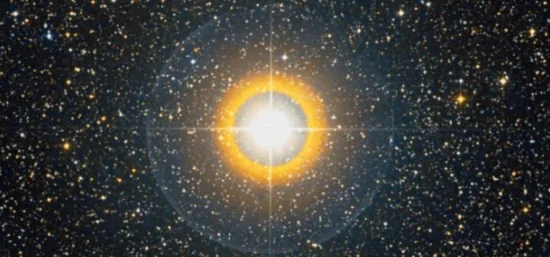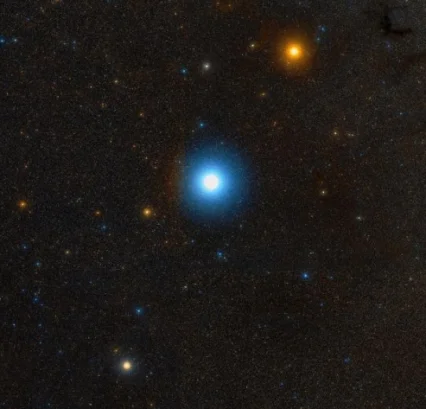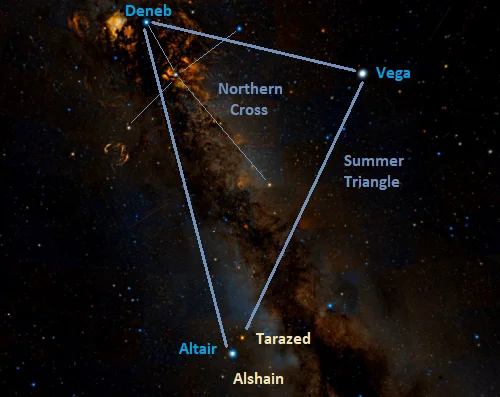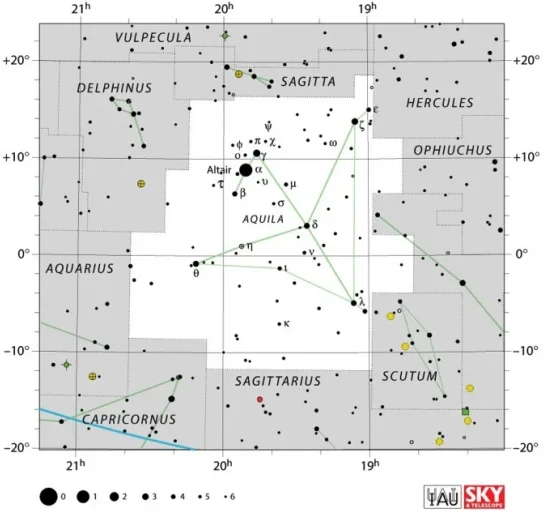Alshain, Beta Aquilae A (β Aql A), is the primary component in a triple star system located in the northern constellation Aquila. With an apparent magnitude of 3.87, it is the seventh brightest star in Aquila. It lies at a distance of 44.7 light years. It is easily recognizable as the fainter of the two stars flanking the bright Altair.
Star system
The Beta Aquilae system consists of three components. The primary star, formally known as Alshain, has the stellar classification G9.5 IV, indicating an evolved yellow subgiant star. Alshain has run out of hydrogen to burn in its core and, after evolving away from the main sequence, it is on its way to becoming a giant.
The star has a mass of 1.26 solar masses and a radius 3.064 times that of the Sun. With an effective temperature of 5,071 K, it is 5.6 times more luminous than the Sun. It spins with a rotational velocity of 22.28 km/s, completing a rotation every 5.08697 days. Its estimated age is between 9.6 and 11.4 billion years.

Alshain (Beta Aquilae), image: Wikisky
With a mass 26% greater than the Sun’s, Alshain spent only about 80 percent of the Sun’s main sequence lifetime burning hydrogen. It shows us the future of the Sun in about 7 billion years, when our star leaves the main sequence.
Alshain is a suspected variable star. Its brightness has been observed to vary by 5 percent of a magnitude.
The companion is a double-lined spectroscopic binary system with the stellar classification M2.5 V, indicating a red dwarf. It is separated from the primary by 13 arcseconds and has a visual magnitude of 12.0. The star shines with only about 2.5 percent of the Sun’s luminosity and has about a third of the Sun’s mass. The physical separation between Beta Aquilae A and B is about 175 astronomical units (Earth-Sun distances).
The Catalog of Components of Double & Multiple Stars (CCDM) lists another companion, a magnitude 10.5 star.
Facts
Alshain and the brighter Altair and Tarazed form the Shaft of Aquila, a 5-degree line also known as the Family of Aquila. The three stars mark the head or neck of the celestial Eagle.

Altair, Tarazed and Alshain (the Shaft of Aquila), image: Wikisky
Alshain is moving in the direction of the solar system with a radial velocity of -40.3 km/s.
The star has served as a stable anchor points for the Morgan-Keenan system of spectral classification since 1943. The MK system is used to classify stars based on the appearance of their spectra. Alshain is one of the several yellow subgiants (along with Muphrid in Boötes and Mu Herculis in Hercules) whose spectra are used to classify other stars.
Even though it has the designation Beta Aquilae, Alshain is only the seventh brightest point of light in Aquila. It is noticeably fainter than Tarazed (Gamma Aquilae), the other star flanking Altair.
In Chinese lore, Alshain and Tarazed represent the children of the Cowherd (Niulang) and the Weaver Girl (Zhinü). In the folk tale, the Cowherd (Altair) and the Weaver Girl (Vega) fall in love, but their relationship is not allowed and they are banished to opposite banks of the celestial river, represented by the Milky Way. They can only meet once a year, when a flock of magpies forms a bridge across the river. The myth is more than 2,600 years old and associated with the Qixi Festival, which celebrates the annual meeting of the pair on the seventh day of the seventh lunisolar month of the Chinese calendar.
The Koori people of southeast Australia saw Alshain and Tarazed as two black swans. The swans were the wives of Bunjil, a wedge-tailed eagle represented by Altair.
Name
The name Alshain (pronunciation: /ælˈʃeɪn/) comes from the Persian Shahin (aš-šāhīn), meaning “the (peregrine) falcon.” It was taken from the Persian name for the constellation. The name was approved by the International Astronomical Union’s (IAU) Working Group on Star Names (WGSN) on August 21, 2016. It formally applies only to the component Beta Aquilae A.
Beta Aquilae was also traditionally known as Unuk al Ghyrab, meaning “the crow’s neck.” The name appeared in the 17th century Egyptian astronomer Al Achsasi al Mouakket’s Calendarium. It was later translated into Latin as Collum Corvi.
The Chinese know Beta Aquilae as 河鼓一 (Hé Gŭ yī), the First Star of River Drum. The Chinese River Drum asterism is formed by Alshain with Altair and Tarazed. It represents military drums in the sky. It is part of the Ox mansion, one of the northern mansions of the Black Tortoise.
In Hindu astronomy, Alshain, Altair and Tarazed formed the 21st nakshatra (lunar mansion), called Çravana (the Ear). They were also associated with the Sacred Fig Tree (Açvattha). The asterism was ruled by Vishnu and it represented the Three Footsteps of the god as he strode through the heavens.
Location
Alshain is easy to find because it lies next to a prominent northern summer asterism: the Summer Triangle. Formed by Altair with the bright Vega and Deneb, the luminaries of the constellations Lyra and Cygnus, the Summer Triangle dominates the sky in the northern hemisphere throughout the summer months. The three stars that form the pattern are easily recognizable. Deneb sits at the top of the Northern Cross, a conspicuous asterism formed by the brightest stars of Cygnus, while Vega lies next to the parallelogram that makes Lyra easily identifiable. Altair is the only one of the three stars flanked by two other relatively bright stars, Alshain and Tarazed. Alshain is the fainter of the two.

The location of Alshain and Tarazed, image: Wikisky
Constellation
Alshain is located in the constellation Aquila. Aquila is one of the larger constellations, stretching across 652 square degrees of the northern sky. It is the 22nd constellation in size. It is easily recognizable because its brightest stars form a bird-like pattern opposite the brighter Cygnus (the Swan).
Aquila is one of the Greek constellations, first catalogued by Claudius Ptolemy in his Almagest in the 2nd century CE. In mythology, it is associated with the eagle that carried Zeus’ thunderbolts, as well as with the eagle that took Ganymede (represented by Aquarius constellation) to Mount Olympus, where he served as cupbearer to Zeus and the other gods.

Aquila constellation map by IAU and Sky&Telescope magazine
Aquila is best-known for the bright Altair, a variable white main sequence star only 16.73 light years away. The constellation contains several other notable stars, including the orange bright giant Tarazed (Gamma Aquilae), the fast-spinning white star Okab (Zeta Aquilae), the Cepheid variable Eta Aquilae, the orange giant Epsilon Aquilae, and the semiregular variable carbon star V Aquilae.
Notable deep sky objects in Aquila include the planetary nebulae NGC 6741 (the Phantom Streak Nebula), NGC 6751 (the Glowing Eye Nebula), NGC 6778, NGC 6781 and NGC 6804, the open clusters NGC 6755, NGC 6709 and NGC 6749, and the globular cluster NGC 6760.
The best time of year to observe the stars and deep sky objects in Aquila is during the month of August, when the constellation rises high overhead in the evening sky. The entire constellation is visible from locations between the latitudes 90° N and 75° S.
The 10 brightest stars in Aquila are Altair (Alpha Aql, mag. 0.76), Tarazed (Gamma Aql, mag. 2.712), Okab (Zeta Aql, mag. 2.983), Theta Aquilae (mag. 3.26), Delta Aquilae (mag. 3.365), Lambda Aquilae (mag. 3.43), Alshain (Beta Aql, mag. 3.87), Eta Aquilae (mag. 3.87), Epsilon Aquilae (mag. 4.02), and 12 Aquilae (mag. 4.02).
Alshain – Beta Aquilae
| Spectral class | G9.5 IV |
| Variable type | Suspected |
| U-B colour index | 0.48 |
| B-V colour index | 0.86 |
| R-I colour index | 0.49 |
| Apparent magnitude | 3.87 |
| Absolute magnitude | +3.03 |
| Distance | 44.7 ± 0.1 light years (13.70 ± 0.04 parsecs) |
| Parallax | 73.00 ± 0.20 mas |
| Radial velocity | −40.066 ± 0.0001 km/s |
| Proper motion | RA: 45.27 ± 0.18 mas/yr |
| Dec.: -481.91 ± 0.20 mas/yr | |
| Mass (β Aql A) | 1.26 ± 0.18 M☉ |
| Luminosity (β Aql A) | 5.60 ± 0.17 L☉ |
| Radius (β Aql A) | 3.064 ± 0.020 R☉ |
| Temperature (β Aql A) | 5,071 ± 37 K |
| Metallicity (β Aql A) | −0.19 ± 0.05 dex |
| Age (β Aql A) | 9.6 – 11.4 billion years |
| Rotational velocity (β Aql A) | 22.28 km/s |
| Rotation (β Aql A) | 5.08697 ± 0.00031 days |
| Surface gravity (β Aql A) | 3.54 ± 0.14 cgs |
| Constellation | Aquila |
| Right ascension | 19h 55m 18.7925630s |
| Declination | +06° 24′ 24.342501″ |
| Names and designations | Alshain, Beta Aquilae, β Aql, 60 Aquilae, HD 188512, HR 7602, HIP 98036, SAO 125235, BD+06° 4357, AG+06 2617, FK5 749, LTT 15822, NLTT 48429, GJ 771, LHS 5350a, GC 27587, GCRV 12266, CSV 101909, PLX 4705, PPM 168947, JP11 3155, UBV 16978, IRAS 19528+0616, 2MASS J19551878+0624238, TYC 493-3355-1, Gaia DR2 4296708789289486080 (β Aql A), WDS 19553+0624, ADS 13110, CCDM J19553+0625, IDS 19504+0609 |
Beta Aquilae B
| Spectral class | M2.5 V |
| Apparent magnitude | 12.0 |
| Parallax | 73.6059 ± 0.0485 mas |
| Radial velocity | -32.9 km/s |
| Proper motion | RA: 22.616 ± 0.078 mas/yr |
| Dec.: -472.296 ± 0.054 mas/yr | |
| Temperature | 3,819 K |
| Right ascension | 19h 55m 18.8268448440s |
| Declination | +06° 24’ 37.485584346’’ |
| Names and designations | Beta Aquilae B, β Aql B, HD 188512B, Gaia DR2 4296708789289490816, BD+06 4357B, ADS 13110 B, CCDM J19553+0625B, GJ 771 B, IDS 19504+0609 B, WDS J19553+0624B |